The article was updated on October 08, 2021.
Honoré de Balzac once said, “Solitude is fine but you need someone to tell that solitude is fine”. Loneliness nowadays is more vivid than ever as people tend to stay at home with their gadgets night after night. But is it what makes us happy? The Harvard study shows that happiness is in our social connections, and luckily, smartphones can help with that.
Tinder app created a new market of dating apps back in 2012 and changed the way we perceive online communication. Now meeting people online does not seem awkward or strange – it is a helping tool for your personal life. While more and more people go online, new Tinder-like apps are hitting the market.
How to create a dating app? What should you know to get off to a smooth start? We have gathered all the answers and ground rules in this article.
Why make a dating app?
The online field changes personal interactions as we know it. By simply swiping, people can pick their date for the night… or even meet the one. Let’s take a look at modern trends that make dating apps a tempting startup idea.
In the US, 30% of adults have used a dating app or website, and 12% have found a serious relationship with them.
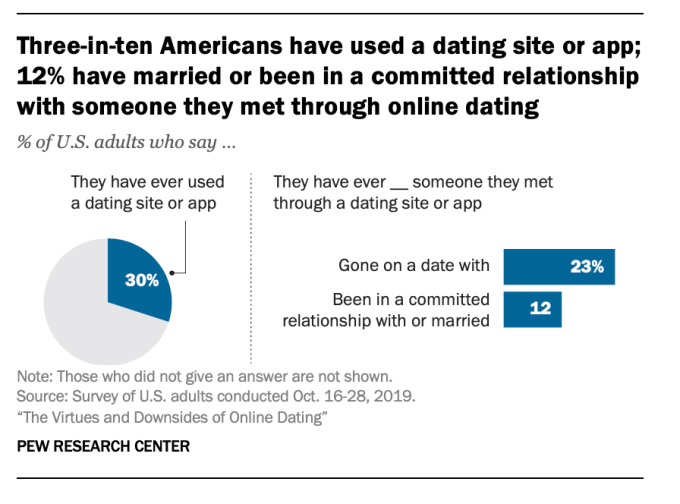
Only in the US, the most popular dating apps have an audience of over a million, and Tinder is an unrivaled leader with an audience of 7.86 million users (September 2019).

And finally, people are not only ready to use dating apps – they want to get extra features as well. The number of paid subscribers for Tinder dating app is growing, and reached 6.03 million people worldwide (first quarter 2020).
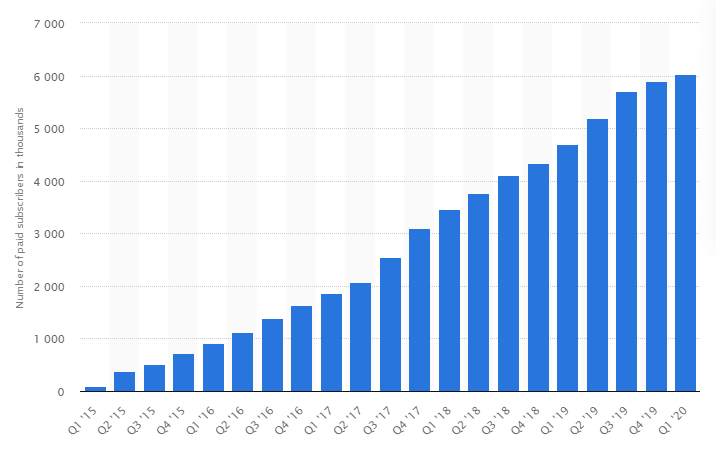
Aided by the accurate and convenient matching algorithms of the dating apps, people can make informed decisions and date only those people who meet their requirements.
With the access to the personal information, one can better understand the other person’s intentions and interests. A precise background check saves time and improves the chances of a successful match.
Despite fierce competition, the dating apps market is still quite promising. In order to enter this market, you need to simply identify your users’ expectations.
What do users expect from a dating app?
What do users realistically expect from a dating app? Obviously, they want it to help them find a perfect match, be it a long-term relationship and marriage or a casual, one-time partner. Thus, the quality of the matching algorithm is a crucial element of any dating app.
In addition to that, users expect their information to be kept private and safe. Most people don’t want to display their personal life or simply don’t feel comfortable sharing their info online.
On the other hand, they want to know for sure that the person they met online is not a criminal and won’t physically assault them on the first date. Therefore, you need to find a way to verify user information and keep it safe at the same time.
How do dating apps work?
Tinder is probably one of the most popular dating apps. Tinder connects users based on their location. User profiles are concise and only require a 500-character bio and up to six images. The app connects to Facebook to verify the user’s age and other possible source information about their work or education.
Using its famous swiping mechanism, users can browse through possible matches. As soon as two users like the pictures of each other, they are matched and can start a chat. The app has a great UX and offers premium features for paid users.
Most importantly, dating apps like Tinder should have a very simple interface. Looking for a date is a funny quest and not a tiring task. Nevertheless, to be helpful, dating apps have a complex algorithm under the hood.
Let’s check it out:
- For simple navigation, you can see only one user on the screen. But at the same time, thousands of other users do the same. So the combination of profiles displayed on the screen is unique and tailored for a specific user.
- There is a random order of accounts to display. Let’s say if two guys have the same search criteria, they still will see other users’ profiles in a different order.
- And there is a separate algorithm responsible for “the matching moment”. It means that the app should not miss if two people like each other and send notifications to both of them simultaneously.

And this is how it works in practice within the Tinder app:
- Picking by swiping. First, users see a person which they can like or pass. This person has been displayed according to the criteria picked in the settings (gender, age, distance, etc.). Swiping right is a like, and swiping left is a pass. Users’ profiles contain information about age, interests, job, education, favorite music, etc. – all this helps in making the final decision.
- It’s a match! If two users like each other, they get a notification about a new match. Only in this case, the two people can start messaging.
- Messaging. This is a simple chat with basic features: no photos or links are allowed within the app to avoid any abusive or inappropriate content.
- Unmatching. Before it goes any further, you can unmatch or report a person if communication is not going well. It means that the chat will be deleted, and messaging between both parties will be disabled.
Must-have features for a dating app
While there are several types of dating apps, from simple and straightforward apps like Tinder to more complex ones, such as OkCupid, there are several basic features that prove to be crucial for any dating app. In our opinion, the most important of them are profiles, matching capabilities, and chat.
The main features
User profile
Probably the most important part of a dating app is a user profile. This might be implemented as a simple questionnaire so that the app learns about your preferences right away and can thus use the information when searching for compatible matches for you.
The other option is for the information to be added manually by the user. The required quantity and the level of detail might vary as well. This can range from a brief bio and a photo to an extended user profile including, your preferences, interests, education or your pet’s name.
In some cases, it makes sense to provide an opportunity for users to link their social media profiles to their account. Probably the most important part of the user profile is the photo, be it a single profile pic or an extended gallery of images.
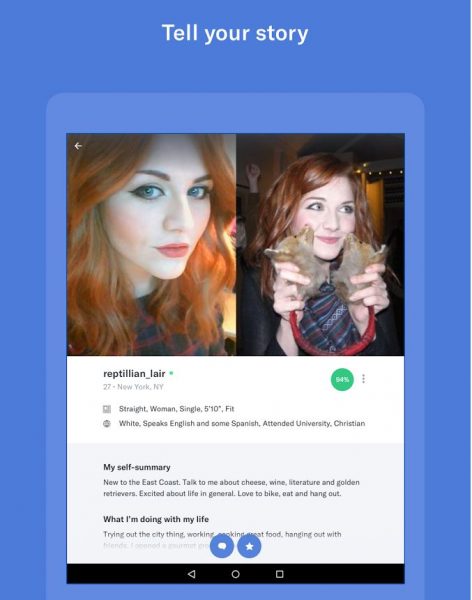
Image source: OkCupid app on Google play
As mentioned above, safety should be your top priority when building a dating app. There are several ways to verify a user’s identity and check the authenticity of the provided info.
Some apps pull this information from Facebook the moment a user links his/her profile. Others use image recognition to verify that you use your real photos. Some might even verify your profiles manually, through an admin panel.
Verification system
Dating apps can be a source of disappointment if users find frauds and fakes there. To create a dating app like Tinder, you should add more trust to the person’s account and your platform in general with a verification system.
There are several verification options:
- social media,
- by phone number, or
- with a photograph.
The more options you provide, the better reputation you will gain on the market and, subsequently, the more users you will get.
Discovery settings
There should be some initial search criteria according to which a dating app displays possible matches to the user. These criteria usually include:
- age (from…to);
- gender;
- distance from one another, etc.
This list can be broadened if your application has a specific topic or is created for people with a common focus of interest.
Swipe
You need only one gesture to pick a date – swipe left or right. In Tinder, if you swipe right, you like a person, and vice versa. It is very simple and that is why it is so addictive. While numerous algorithms display the best possible matches specifically for you, it remains a pure entertainment for the final user.
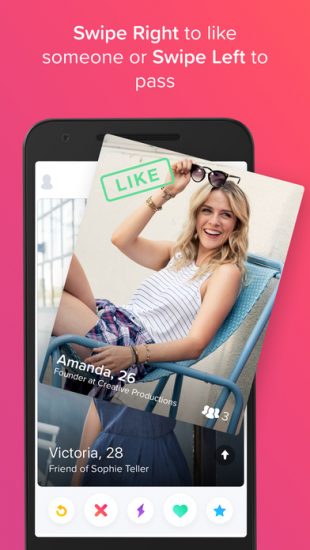
Matching algorithm
The core feature of any dating app is the ability to match people based on different metrics. This might be as simple as finding people near you. On the contrary, you might use a complex algorithm to analyze user information and find similar profiles or the ones with matching interests and preferences.
Such algorithms would typically use machine learning techniques to learn from successful or failed matches and adjust the future suggestions accordingly, improving their quality and accuracy.
Messaging/Chat
As soon as two people make a match, they can start a conversation. Messaging is a perfect way to strike up an acquaintance. It is an easy, fun and engaging way to flirt and get to know one another. You can spice up your chat with emojis, stickers, or multimedia sharing to make the experience complete.
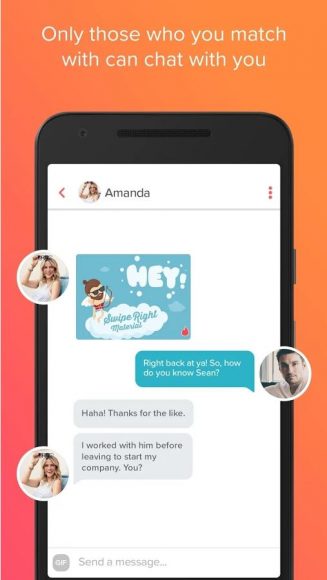
Image source: Tinder app on Google Play
Most dating apps typically restrict access to this function for those users who are not matched. This prevents tons of spam messages from random users whom with you are not interested in. Be careful because this restriction might lead to poor engagement. If for example, two users can’t decide who should text first after they were matched, they will simply continue to swipe through their recommendations.
In order to motivate users to start a conversation, some apps have introduced additional terms. For example, Bumble requires women to text first and set the 24-hour time limit for starting a conversation.
Admin panel
It is impossible to create a dating app without the admin panel – this is the captain’s cabin for any web or mobile app. Here you can manage the app according to your role in the project (technical support, content management, marketing, etc.). Everything happening with and within the application is displayed here: payments, user analytics, disputes, technical issues, and so on.
Additional features
User communities
To create a more meaningful experience, besides finding a match, some apps offer users an option to join interest-based communities and communicate with like-minded people. Similar features can be seen on Grindr (“Tribes”) or OkCupid (“Flavors”) to better identify a user and adjust matching recommendations accordingly.
Push notifications
Push notifications help you keep your users engaged at all times. As soon as there is any activity, such as a new match or a message, a user will get notified by the app.
While this feature is certainly a valuable add-on in terms of user retention, sometimes notifications might get overly intrusive or too frequent. To solve this, there should be an option to enable/disable notifications.
Advanced features
Geolocation
As a way to discover new people, geolocation proves to be a very useful tool. Using your current location, the app can search for matches around you. This is specifically useful for apps that have a focus on dating activities.
If you are matched with a person who is within your vicinity, you can skip the flirting and the chatting and go straight to meeting somewhere for lunch, perhaps go for a bike ride, or participate in any other interesting dating activities.
Integration with social networks
To add a little more personality to the account, you can provide integration with Instagram. Apart from account photos, other users will be able to see what a person posts every day in social media – it can add a couple of strokes to the final portrait.
Also, apps like Tinder provide integration with Spotify: the easiest way to claim your music preferences, favorite songs, and genres.
Paid features
As mentioned above, premium capabilities and additional features, such as in-app gifts, profile promotions, or unlimited access to typically restricted features, are some of the most powerful monetization tools for a dating app.
Spam detector
Spam follows us everywhere we go, and dating apps are not an exception. To help users get rid of annoying messages, you can add a spam detector to the list of features. It works this way: a user gets a notification if the same message has been sent to several people at once.
Examples of Tinder alternatives
There are dozens of dating apps out there. Ones focusing on specific niche audiences like LGBT communities, geeks, Jewish people, senior people or music lovers, and others that are catering to a wider audience.
Let’s take a look at the best dating apps and define their strengths.
It is probably one of the most popular dating apps. Tinder connects users based on their location. User profiles are concise and only require a 500-character bio and up to six images. The app connects to Facebook to verify the user’s age and other possible source information about their work or education.
At the very beginning, this app’s specific feature was that it helped users find a date among their friends’ connections on social media. But that was not enough for an engaging experience.

Detailed profiles is what helped this app stand out – they look more interesting than the ones on Tinder. For example, you can find out the person’s religious or political views or if that individual is ready to have kids sometimes in the future. In other words, this app was built to help people build serious relationships.
The special thing about this app is that women should make the first step. According to the app’s creators, they encourage respect and equality with such an approach.
Strictly speaking, Bumble is a multi-functional platform: women can find a date, a friend, or a business contact – all within one tool. To spice it all up, developers added the video chat feature to the list.

Unlike Tinder, OkCupid dating app doesn’t use Facebook to login. New users fill out their profiles by answering a long list of questions while also having to suggest answers that they would like to hear from their potential matches. Using this information and a percentile score, the app then calculates the users’ compatibility.
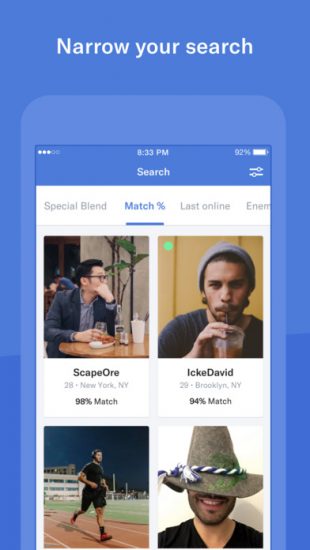
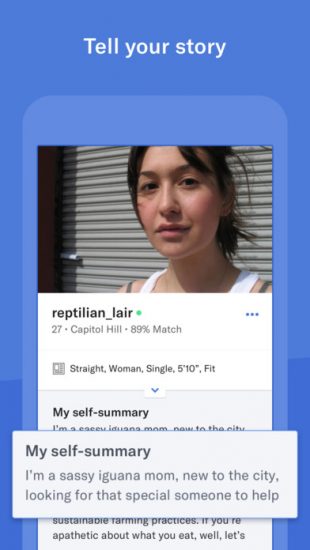
A distinct feature of this app is that you don’t have to like a person to allow him/her to text you. Be this a drawback or an advantage, the result of this feature is that anyone can send you a message, which often leads to huge amounts of spam or unwanted texts from people you don’t like.
This app uses a completely different approach to matching people. Based on your Facebook account, the app will select and offer a potential match, but only one “bagel” per day.
The chat feature has a number of restrictions. It is only available to the people who liked each other. It creates a sense of urgency because the match expires in 8 days, which prompts the users to exchange phone numbers and meet in real life instead of simply chatting for weeks.
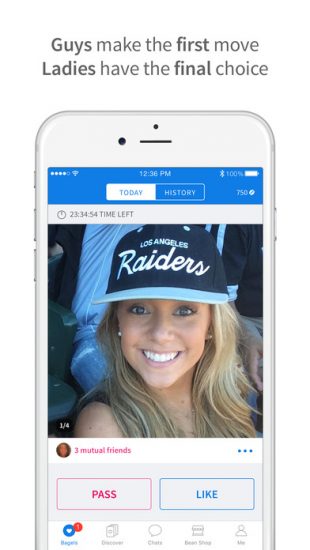
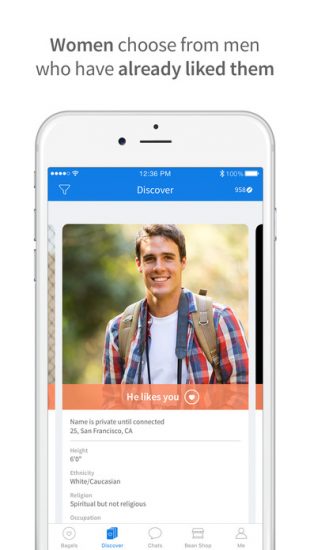
The app has various gamification features which give users the opportunity to earn points and unlock premium features.
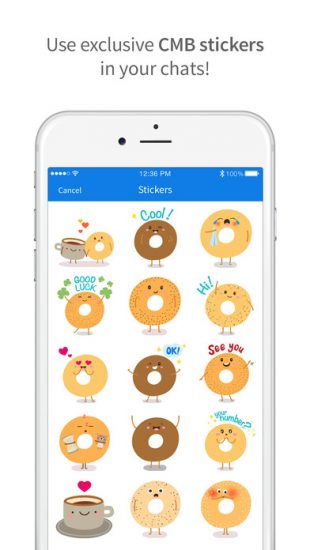
Things to consider before making a dating app
There are some fundamental things you should think about before dating app development. What else would be a good idea to consider when the development team is ready to start coding?
1. Decide on your niche
If you look through the apps we have mentioned in this article, each of them has its very own specific trait. If you want to find the same for your product, good old market research will help in this case.
This is where you can begin:
- First, you should check who your closest competitors are, what the market can offer.
- Check the comments from users – what are they looking for in the Tinder-like apps? What drawbacks do they find most annoying about these apps?
- Check forums and social media. Maybe, you will find a particular group of people who needs a separate platform for communication.
2. Pick a business model
You already know there are several ways to monetize your future dating app – now is the right moment to pick your option. Why is it important from the very beginning?
- The final list of features depends on it.
- The user flow and interface design are developed before the coding stage, and they should consider if and when users pay for extra features.
- This is an important detail for the marketing team to know when they start building a promotional strategy.
How to monetize your dating app?
Despite being mostly free to use, the potential for dating apps to be lucrative is quite high.
There are several ways to monetize a dating app:
- Subscription-based services (premium accounts, additional features) – Tinder Plus, for example, offer a number of extra features, such as Unlimited Swiping or Rewind, on a monthly subscription basis.
- In-app purchases (gifts, chat stickers, various profile boosts) – OkCupid, for a small cost, offers the option to boost a user’s profile visibility by placing it in the “Spotlight” section, thus increasing the likelihood that a match will be made.
- Advertising – (banner ads and native mobile advertising) – Some dating apps choose to show in-feed ads to make money. The ability to turn the ads off can be provided as a paid service as well.
- Integration with offline services – Another option is to make money through paid partnerships with offline businesses. You can make money each time your users go through a partner service such as, eating at a restaurant or booking an Uber.
3. Make user privacy a priority
Sometimes, people are glad to share some of their private data with complete strangers. Dating apps are one of those places where you leave your name, job title, and location – that is why numerous dating apps care a lot about privacy and security issues.
In 2019, OkCupid’s users reported that their accounts were hacked: their passwords and emails were changed, and subsequently, could not get their accounts back.
So, even before thinking about how to make a dating app, think about all possible security leaks. In this regard, it is better to consult security experts.
4. Make it fun with gamification
If you can add at least some gamification to your app, just go for it. People open dating apps to relax, have fun, and enjoy their free time. Your product should be exciting, engaging, simple, and useful.
Tinder’s swiping has created a revolution in the world of online dating and made matching kind of addictive. You can provide users with bonuses for adding all the information to their accounts and then suggest bonuses here and there in the user flow.

Wrapping up
All in all, building a dating app is not an easy task. While there are plenty of great dating apps, most of them have much in common, providing the same set of features with a slightly different UI.
If you want to compete with the major market players, you need to find a unique way to outshine their products, be it through a better UX, more accurate matching capabilities, or extra features.
How to get started?
The product discovery phase is the best first step you can take to lay a solid foundation for the development of your app. It includes a functional specification, UX/UI design, and a visual prototype that will give you a clear vision of the end product. On average, this phase takes 4-6 weeks.
The product discovery phase can help you:
- define a full scope of work and develop a roadmap for the project
- set a realistic budget for your MVP and plan your resources
- test the waters with your audience using a visual prototype
- craft a convincing investment pitch
- get to know your team
Having a proven track record of building successful mobile startups, we at Eastern Peak can help you create a winning strategy and develop a dating app that your users will love. So just contact us and share your idea!
Read also:



